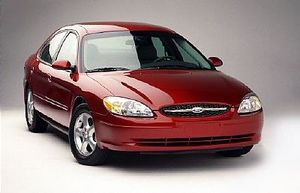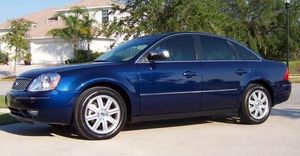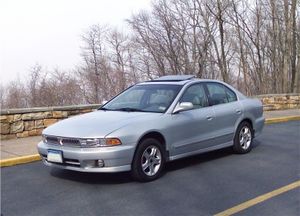Sedan
Car Show
Sedan
Sports sedan | 6 passenger Sedans | Family car | Luxury car
 A
Ford Taurus, a recognizable sedan.
A
Ford Taurus, a recognizable sedan.
 The
Ford Five Hundred, a large sedan.
The
Ford Five Hundred, a large sedan.
A sedan
car,
American English terminology (saloon in
British English), is one of the most common
body styles of the modern automobile. At its most basic, the sedan is a
passenger car with a separate
hood covering the engine in the front, and a separate trunk for luggage at the rear—the archetypical "3-box" car.
Historically, the usage of the term sedan has changed over time.
Several versions of the body style exist, including four-door, two-door and
fastback
models.
Description
A sedan seats four or more and has a fixed roof that is full-height up to the
rear window. Most commonly it is a four-door; two-door is rarer but they do
occur (more so historically). In the U.S., this term has been used to denote a
car with fixed window frames, as opposed to the hardtop style where the sash, if
any, winds down with the glass. As hardtops have become rarer, this distinction
is no longer so important.
Types of sedan
Two-door sedan
A two-door sedan is defined by the
SAE as any two-door model with rear accommodation greater than or equal to 33
cubic feet (0.934 m³) in volume (a calculation made by multiplying the legroom,
shoulder room, and headroom). By this standard, the Chevrolet Monte Carlo,
Ferrari 612 Scaglietti, and Mercedes-Benz CL-Class coupes are all two-door
sedans. Only a few sources, however (including the magazine Car and Driver), use the two-door sedan label in this manner.
In the popular vernacular, a two-door sedan is defined by appearance and not
by volume—vehicles with a so-called formal roofline are called two-door
sedans, while those with the more common sloping backlight are called coupes.
This has led to the so-called four-door coupe, which is a sedan with
classic coupe-like proportions. The designation was first applied by Rover to a
variant of its P5 from 1962 until 1973. It has more recently been adopted by
DaimlerChrysler for the Mercedes-Benz CLS-Class, which the Mercedes marketing
department has erroneously called the first four-door coupe. Other companies are
leaping into the segment as well, but the term four-door coupe is entirely
aesthetical, and not the product of any formal definition. To make matters even
more clouded, the Mazda RX-8 meets the
volume requirement to be called a sedan, but it has vestigial rear-hinged rear
doors, making it a 2+2-door sedan.
Hardtop and fastback sedans
Sometimes a particular fastback or hardtop
car
body style is referred to as a sedan. Both have the classic trunk (boot) at
the rear of the vehicle. Classically a sedan will have a frame around the door
windows, while the
hardtop has
frameless door glass. The hardtop design can be considered separately (i.e., a
vehicle can be simply called a four-door hardtop), or it can be called a hardtop
sedan. During the 1970s, hardtop sedans were often sold as sport sedans
by American manufacturers. The more contemporary four-door sedans with B-pillars
were called pillared hardtops or pillared sedans during this
period. The sport sedan term has since been appropriated for other uses.
A fastback sedan is simply a four-door sedan with a sloping rear deck, but still
a separate trunk. An example is the 1978–80
Buick
Century. In a way, the discussion is entirely academic, since no fastback or
hardtop four-door sedans are built today.
Hatchback sedan
Hatchback
(a.k.a. liftback) sedans are often described as well. Here, the car has fastback
profile but instead of a trunk lid, the entire back of the vehicle lifts up
(using a liftgate or hatch). A vehicle with four passenger doors and a liftgate
at the rear can be called a four-door hatchback, four-door hatchback sedan, or
five-door sedan. There can also be two-door hatchback sedans (three-door
sedans), by the same technical explanation for two-door sedans. An example of
this type is the Volkswagen GTI. Whether this is recognized by the SAE, or
whether hatchbacks are not sedans by technical definition, is not known at this
time of writing.
Small sedans
Sedan bodystyles on smaller cars are now less popular after the hatchback
revolution during the 1970s, although many hatchbacks also form the basis of
sedans. The first major European manufacturer to phase out sedans in favour of
hatchbacks was Renault, who invented the hatchback (Renault 4) in 1965. The
3-box sedan bodystyle is still used on almost all large and luxury cars,
excluding the Renault Vel Satis—which has not been especially successful.
Terminology
 The Mitsubishi Galant, a midsize sedan.
The Mitsubishi Galant, a midsize sedan.
Origin
The word sedan is possibly derived from a southern
Italian dialect derivative of Italian sede "chair" (the first sedan
was said to have been introduced from Naples). The derivation from the town of
Sedan
in France, where it was said to have been made or first used, lacks historical
evidence, according to
OED. The word sedan was later used to refer to a
litter or windowed box containing a passenger seat carried by two or more
bearers.
International terminology
In
British English the configuration is called a saloon and has its
engine under the bonnet at the front, and a boot for luggage at
the rear. The British English term is sometimes used by British car
manufacturers in the United States: the
Rolls-Royce Park Ward was sold as a saloon in the United States, while the
smaller Silver Seraph was called a sedan.
In Australia and New Zealand, the American term is now used, albeit with the British terms of
boot and bonnet being retained. In other languages, sedans are known
as
Limousine (German),
Berline (French),
Berlina (Spanish
and
Italian), although these terms also may include hatchbacks. These terms,
besides sedan, derive from types of
horse-drawn carriages.
Home | Up | List of cars | Vehicle size class | Microcars | Hatchback | Sedan | Station wagon | Sportive cars | Cabriolet | Convertible | Four-wheel drive | Minivan | Brass Era car | Personal luxury car | Recreational vehicle | Vintage car | Full-size vehicles | Keicars | Hybrid vehicles | Luxury vehicles | Mid-size car | Pickup trucks | Prestige vehicles | Production Electric vehicles | 2 plus 2 | Air car | Compact SUV | Concept cars | Cyclecar | Leisure activity vehicle | Limousine | Personal luxury car | Pony car | Professional car | Safety car | Show car | Sport compact | Voiturette | Green vehicles | Off-road vehicles | Steam automobiles
Car Show, made by MultiMedia | Free content and software
This guide is licensed under the GNU
Free Documentation License. It uses material from the Wikipedia.
|







